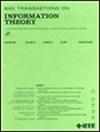涉及σ内积的经典码与量子码
IF 2.9
3区 计算机科学
Q3 COMPUTER SCIENCE, INFORMATION SYSTEMS
引用次数: 0
摘要
2019年,Carlet等人引入了涉及$\sigma $内积的线性码$\sigma $对偶的概念,它推广了欧几里得、厄米和$\ell $ -伽罗瓦情况。本文的重点是在$\sigma $内积的框架内构造新的和改进的经典码和量子码。我们推导了线性码,包括矩阵积(MP)码关于$\sigma $内积的一些一般性质。我们提出了构造$\sigma $自正交(SO)和$\sigma $双含(DC) MP码的一般方法并设计了涉及某些优化问题的有效路线。我们的方案有效地生成许多具有新参数或最优参数的此类代码。从经典码出发,建立了量子稳定码的$\sigma $结构。我们提出了一种基于一般线性码的$\sigma $壳构造两类一般纠缠辅助量子纠错码(EAQECCs)的统一方法。这进一步产生了六种类型的eaqecc,这些eaqecc具有灵活的参数,基于欧几里得和厄米情况下使用MP码的传播规则。与已知的三元EAQECCs相比,我们得到了17个新的EAQECCs,其中13个参数有所改进。最后,我们给出了长度分别为$(q^{2}-1)(q+2)$和$q^{2}(q+2)$的两个q-ary EAQECCs无穷族。这些家族包括许多q-ary qecc,根据Grassl的在线数据库,这些家族不仅是新的,而且超过了Edel的在线数据库中列出的家族。本文章由计算机程序翻译,如有差异,请以英文原文为准。
Classical Codes and Quantum Codes Involving the σ Inner Product
In 2019, Carlet et al. introduced the concept of $\sigma $ duals of linear codes involving the $\sigma $ inner product, which generalizes the Euclidean, Hermitian and $\ell $ -Galois cases. This paper focuses on constructing new and improved classical codes and quantum codes within the framework of the $\sigma $ inner product. We derive some general properties of linear codes, including matrix-product (MP) codes, with respect to the $\sigma $ inner product. We develop general methods and design effective routes involving certain optimization problems for constructing $\sigma $ self-orthogonal (SO) and $\sigma $ dual-containing (DC) MP codes. Our schemes efficiently generate numerous such codes with new or optimal parameters. We establish the $\sigma $ construction of quantum stabilizer codes from classical codes. We propose a unified method for constructing two general classes of entanglement-assisted quantum error-correcting codes (EAQECCs) based on the $\sigma $ hulls of general linear codes. This further yields six types of EAQECCs with flexible parameters based on propagation rules using MP codes under the Euclidean and Hermitian cases. Compared to the best-known ternary EAQECCs, we obtain 17 new ones and 13 of them have improved parameters. Finally, we present two infinite families of q-ary EAQECCs with lengths $(q^{2}-1)(q+2)$ and $q^{2}(q+2)$ , respectively. These families include many q-ary QECCs that are not only new according to Grassl’s online database but also surpass those listed in Edel’s online database.
求助全文
通过发布文献求助,成功后即可免费获取论文全文。
去求助
来源期刊

IEEE Transactions on Information Theory
工程技术-工程:电子与电气
CiteScore
5.70
自引率
20.00%
发文量
514
审稿时长
12 months
期刊介绍:
The IEEE Transactions on Information Theory is a journal that publishes theoretical and experimental papers concerned with the transmission, processing, and utilization of information. The boundaries of acceptable subject matter are intentionally not sharply delimited. Rather, it is hoped that as the focus of research activity changes, a flexible policy will permit this Transactions to follow suit. Current appropriate topics are best reflected by recent Tables of Contents; they are summarized in the titles of editorial areas that appear on the inside front cover.
 求助内容:
求助内容: 应助结果提醒方式:
应助结果提醒方式:


